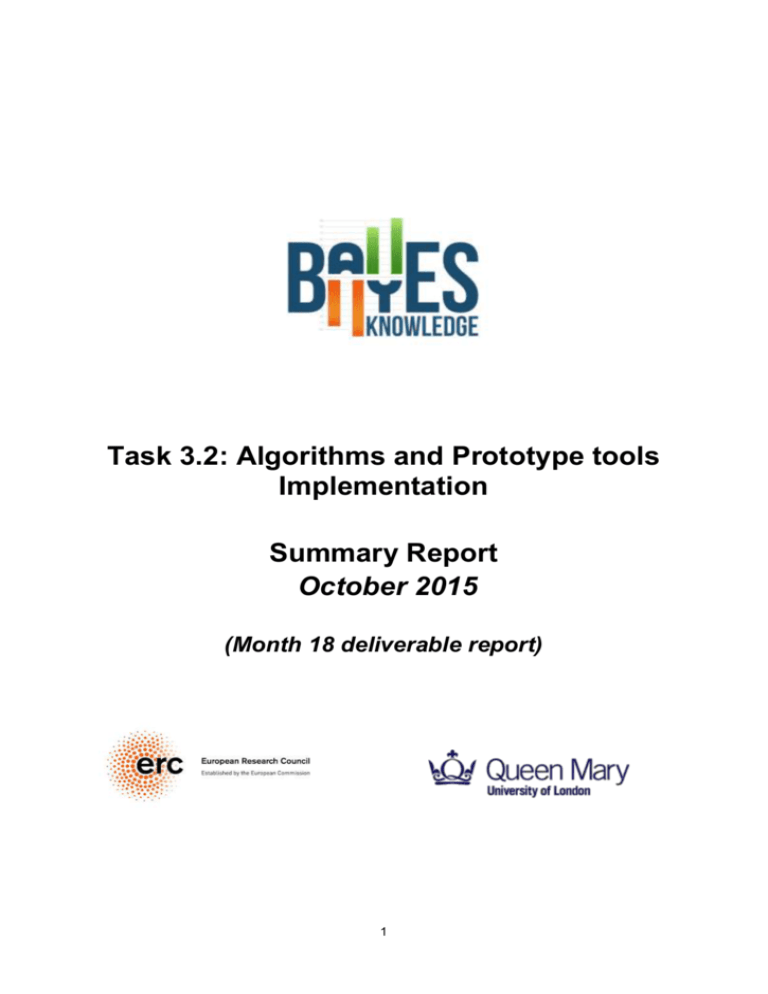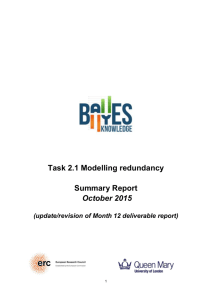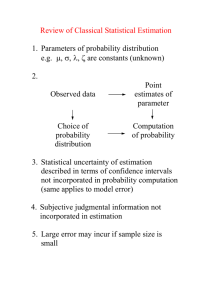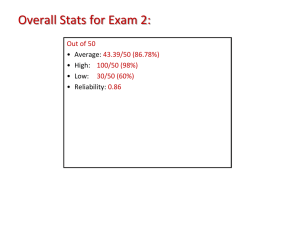Task 3.2 Summary Report Sept 2015
advertisement

Task 3.2: Algorithms and Prototype tools Implementation Summary Report October 2015 (Month 18 deliverable report) 1 Table Learning from Data and Knowledge Much of the prototype tool development work has focused on the core BAYESKNOWLEDGE problem of combining data and knowledge for Bayesian Network table (i.e. parameter) learning. We are currently finalising an implementation (including novel GUI) that extends the Expectation-Maximisation algorithm to take into consideration both data and expert knowledge. More specifically, the user will be provided with the option to specify subjective probabilities for any of the model variables, and also indicate his or hers degree of confidence with respect to the indications, as well as relative to the data taken into consideration for parameter learning. The outcome would be a model learned from a dataset with missing data, where missing data is approximated and where the estimated model is weighted against expert beliefs. Other algorithmic work undertaken: Peng Lin, Martin Neil, Norman Fenton (2015) Region Based Approximation for High Dimensional Discrete Bayesian Network Models, to be submitted to IEEE Pattern analysis and Machine Intelligence. This work is potentially ground-breaking. Performing efficient inference on Bayesian Networks (BNs), with large numbers of densely connected variables is challenging. With exact inference methods, such as the Junction Tree algorithm, clustering complexity can grow exponentially with the number of nodes and so becomes computationally intractable. This paper presents a general purpose approximate inference algorithm called Triplet Region Construction (TRC), which reduces the clustering complexity from worst case exponential to polynomial. We employ graph factorization to reduce connection complexity and produce clusters of limited size. TRC is guaranteed to converge and the experiments show that this new algorithm achieves accurate results when compared with exact solutions. The TRC algorithm is defined on BNs with discrete nodes, but can be used on hybrid BNs since any continuous node can have an approximated discrete node probability table. Zhou, Y., Fenton, N. E., & Neil, M. (2014). An Extended MPL-C Model for Bayesian Network Parameter Learning with Exterior Constraints. In L. van der Gaag & A. J. Feelders (Eds.), Probabilistic Graphical Models: 7th European Workshop. PGM 2014, Utrecht. The Netherlands, September 17-19, 2014 (pp. 581–596). Springer Lecture Notes in AI 8754. Lack of relevant data is a major challenge for learning Bayesian networks (BNs) in real-world applications. Knowledge engineering techniques attempt to address this by incorporating domain knowledge from experts. The paper focuses on learning node probability tables using both expert judgment and limited data. To reduce the massive burden of eliciting individual probability table entries (parameters) it is often easier to elicit constraints on the parameters from experts. Constraints can be interior (between entries of the same probability table column) or exterior (between entries of different columns). In this paper we introduce the first auxiliary BN method (called MPL-EC) to tackle parameter learning with exterior constraints. The MPL-EC itself is a BN, whose nodes encode the data observations, exterior constraints and parameters in the original BN. Also, MPL-EC addresses (i) how to estimate target parameters with both data and constraints, and (ii) how to fuse the weights from different causal relationships in a robust way. Experimental results demonstrate the 2 superiority of MPL-EC at various sparsity levels compared to conventional parameter learning algorithms and other state-of-the-art parameter learning algorithms with constraints. Moreover, we demonstrate the successful application to learn a realworld software defects BN with sparse data. Zhou, Y., Fenton, N. E., Hospedales, T, & Neil, M. (2015). "Probabilistic Graphical Models Parameter Learning with Transferred Prior and Constraints", 31st Conference on Uncertainty in Artificial Intelligence (UAI 2015), Amsterdam, 13-15 July 2015. Learning accurate Bayesian networks (BNs) is a key challenge in real-world applications, especially when training data are hard to acquire. Two approaches have been used to address this challenge: 1) introducing expert judgements and 2) transferring knowledge from related domains. This is the first paper to present a generic framework that combines both approaches to improve BN parameter learning. This framework is built upon an extended multinomial parameter learning model, that itself is an auxiliary BN. It serves to integrate both knowledge transfer and expert constraints. Experimental results demonstrate improved accuracy of the new method on a variety of benchmark BNs, showing its potential to benefit many real-world problems. Zhou, Y., Fenton, N. E. (2015), "An Empirical Study of Bayesian Network Parameter Learning with Monotonic Causality Constraints", submitted International Journal of Approximate Reasoning Learning accurate Bayesian networks (BNs) is a key challenge in real-world applications, especially when training data are hard to acquire. The conventional way to mitigate this challenge in parameter learning is to introduce domain knowledge/expert judgements. Recently, the idea of qualitative constraints has been introduced to improve the BN parameter learning accuracy. In this approach, the exterior parameter constraints (between CPT entries of different parent state configurations) are encoded in the edges/structures of BNs with ordinary variables. However, no previous work has investigated the extent to which such constraints exist in the standard BN repository. This paper examines such constraints in each edge of the BNs from the standard repository. Experimental results indicate such constraints fully or partially exist in all these BNs, and our slightly improved constrained optimization algorithm achieves great parameter learning performance, especially in large BNs. These results can be used for guiding when to employ exterior constraints in parameter estimation. This has the potential to benefit many real-world case studies in decision support and risk analysis. Zhou, Y., Hospedales, T., Fenton, N. E. (2015), "When and where to transfer for Bayes net parameter learning", Submitted Machine Learning Journal Learning Bayesian networks from sparse data is a major challenge in real-world applications, where data are hard to acquire. Transfer learning techniques attempt to address this by leveraging data from different but related problems. For example, it may be possible to exploit medical diagnosis data from a different country. A challenge with this approach is heterogeneous relatedness to the target, both within and across source networks. In this paper we introduce the first Bayesian network parameter transfer learning (BNPTL) algorithm to reason about both network and fragment relatedness. BNPTL addresses (i) how to find the most relevant source network and network fragments to transfer, and (ii) how to fuse source and target parameters in a robust way. In addition to improving target task performance, explicit 3 reasoning allows us to diagnose network and sub-graph relatedness across BNs, even if latent variables are present, or if their state space is heterogeneous. This is important in some applications where relatedness itself is an output of interest. Experimental results demonstrate the superiority of BNPTL at various sparsity and source relevance levels compared to single task learning and other state-of-the-art parameter transfer methods. Moreover, we demonstrate successful application to real-world medical case studies. 4









